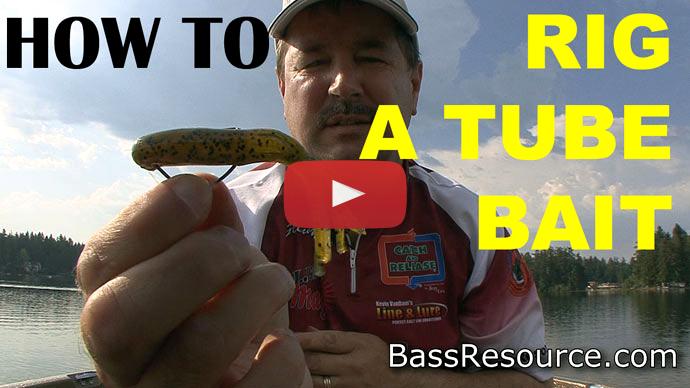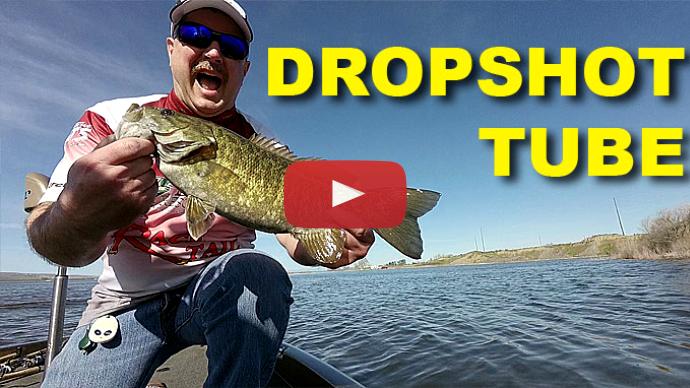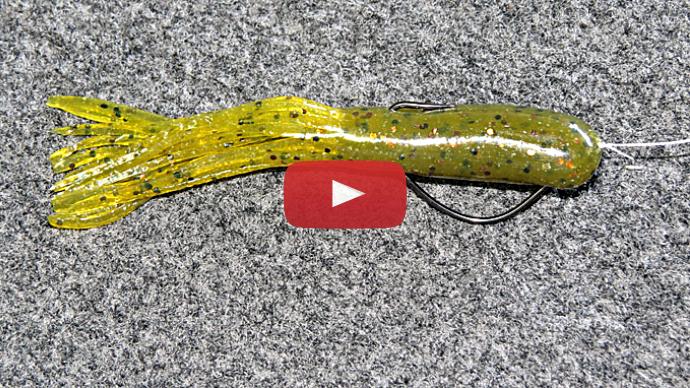All right, let's talk about spring tube tactics for bass fishing. Yeah, tubes, they catch a lot of bass during the spring, especially if you rig them these ways. There's a lot of different ways to rig tube baits, but during the spring, I narrow it down to these particular choices.
First one is on a jig head with a 90-degree eye on it. This is, like, the original way we used to fish them back when the tubes came out in the '80s. The eye stands straight up and a little bit back from the front of the tube, and the reason for that is, when you cast it out, you actually do this on a slack line. Use spinning gear, a medium light power rod, medium light action spinning rod, maybe a seven-foot at the most. I like to put it on a six-pound test, guys, six-pound fluorocarbon. I use real light line. That might be a little scary for some of you. You can go up to 10-pound, that's fine. But I like to use light line because it gives the bait a little more action. Rig it on this 90-degree jig head and an eighth-ounce, at the most, somewhere between a sixteenth- and an eighth-ounce, real light, throw it out there.
And with that jig head, with the eye sticking straight up, what happens is, when it falls, it does this death spiral all the way down. It is the only bait for bass fishing that does that action. The only bait. And that spiral action as it falls down, a lot of bass fall for it, man. They just snatch it up and just gobble it down. Man, it is a bass-catching setup. I like to throw it around docks, skip it under docks. I like to throw it anywhere where they could be hiding out, like along the weed edges or flats with scattered boulders and stumps. It works in a variety of areas this spring, especially in clear water. It is more of a site-type lure, so you need a little bit clearer water for the bass to find it. It's not going to work as well in real muddy water, although I've caught fish doing it that way. But the clearer water, the better. Green pumpkin is great. I like to use a color called old ugly. It is kind of between baby diaper yellow and green pumpkin color. It is hard to explain it, but here's a picture of it. You can get an idea of what it looks like. And you can use it with or without salt and pepper in it. Either way, it works really, really well, and yeah, you'll catch a lot of fish doing that.
Now, a variation of that is to use a jig that has a 60-degree eye to it, and the shape of the jig head itself is more of kind of this oval egg shape, and the eye tie sticks out more to the front of the bait. That changes the action dramatically. Now, when you throw it, the bait swims. It glides instead of spiraling. So this works really well when you're covering water, you want to have more of a bait fish imitation. You can just cast out, and you give it a little twitch, and it glides and starts to fall down. You give it a little twitch, it pops back up and glides some more. It looks like a meandering, helpless minnow that's lost its way. Easy target for bass. And again, you can cover all those areas I just mentioned before with this exact presentation. Especially when the bass are aggressive, this works very, very well. Same colors as well. If it's really clear water, I like to go to a smoke color or a clear with salt and pepper, maybe with a little silver in it or a gold flake, something that has a little bit of flash to it to capture the attention of the bass. But that's all you need, nothing real crazy.
Now, another way that works particularly well for smallmouth is fishing a tube on the back of a split-shot rig or some guys call it a Mojo Rig. It's a cylindrical weight that's about an eighth ounce or less weight. I put about two-foot to two-and-a-half-foot distance between the weight and the hook. I can rig that bait weedless. That works really well with this setup because you can work it through weeds and through cover really well without getting snagged, rocky areas without getting it caught in the rocks. This is particularly good in the early part of the spring but works all the way up until they're spawning. I like to fish this a lot because I cover a lot of water. It's amazing how fast you can cover water on a finesse tactic like this. A lot of folks think finesse is simply really slow, and that's it. That's not true. It's just a style of presentation. You can fish it fast. And this time of year, when the bass are aggressive, it works really well. This tube bait, it'll imitate either a craw or a baitfish, doesn't really matter unless the bass are really keen on one or the other. But either way, you'll still catch a lot of fish.
A little trick I like to use with this is I like to take a little piece of a toothpick, break it off, and put it towards the back end of it, and it holds open the hole of that tube. Blow out the water or shake it loose and get the water out of it. Throw it out there. What happens is the weight falls down, the bait floats behind it, sits up here until the pressure gets to it with that little bit of air in it. It'll come out. It actually blows a little bit of a bubble and then it falls. That is bass candy. It's an action that a lot of bass haven't seen. They'll follow it. This works especially well if you're not getting a lot of bites. They'll follow it, and then the bait stops, and they look at it. Sometimes that stop will get them to bite too when it's floating right above the weight. But it sits there, and they're looking like, "I don't know." They start to maybe swim off. And then a bloop and it falls again. Wham. They will annihilate it. I mean, the strikes are pretty vicious. You'd be surprised. So that little tidbit, that little trick can get you a lot more bites with a tube bait on a split-shot rig, so try that out.
Now, this next presentation is another one a lot of bass anglers don't use this time of year, and that is flipping and pitching a tube bait. Now, some folks think you got to have a special tube that's got a thicker wall to it and it stands up better. I've tried both, and I don't see a significant difference. A thicker tube, thicker wall tube, does last a little bit longer but not significantly longer. I just use a regular tube bait in this instance. I rig it Texas-style with a quarter-ounce, maybe a three-eighth-ounce bullet sinker. Then I rig it with a Trokar hook, is what I use. I'll have a link here on the bottom of it. You can get to it. It's a thicker style of hook that's designed for flipping and pitching, and it makes the tube weedless. That's critical because, here, you're targeting bass that are in pre-spawn stages that are getting ready to move up and spawn, so those areas that are a little bit deeper water next to flats. And typically, they're buried up in bushes, flooded trees, brush piles. They're buried up in the weeds, something thick cover. They like to sit in there as they make their way up shallow. And this rig is perfectly suited for that.
This bass, in particular, that you see right here, I caught him using it in eight feet of water, and this is some flooded trees. He was buried up in there, and I was just flipping along these trees. And there he was, and it's a good size bass. So you got to put this on stronger, stouter equipment. So you're using 50-pound line, braided line, and I use stout gear. This is a medium heavy to heavy power rod, seven-foot-four, fast action rod, and it's really good for flipping and pitching. That's a great setup for wrenching these bass out of this kind of cover. So give that a go. Matter of fact, give all these rigs a go during the spring, and you can catch a lot of bass on tubes.
Hope that helps. For more tips and tricks like this, visit bassresource.com.



